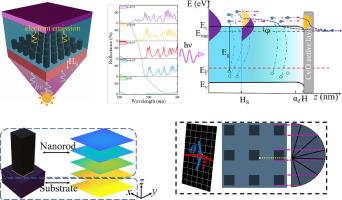透射模式AlGaN纳米阵列光电阴极从光子激发到电子收集四步的三维输运机制
IF 6.9
2区 材料科学
Q2 CHEMISTRY, PHYSICAL
引用次数: 0
摘要
本研究的重点是透射型氮化铝纳米阵列阴极的光发射模型。通过引入与能量相关的吸收系数和光电子逃逸概率的新计算方法,我们建立了一个三维透射光发射模型。在光发射模型的基础上,探讨了多个参数(几何、表面、环境、材料)对阴极性能的影响。研究发现,在高能光子照射下,量子效率(QE)会获得更好的响应。当纳米阵列的高度为 90 纳米、直径为 60 纳米时,量子效率(QE)会产生高达 24.6% 和 22.4% 的高响应。当外部电场小于 1 V/μm 时,外部电场的增强可以提高有效量子效率(EQE),尤其是当小于 4 eV 的低能光子入射时。铝成分从 0 增加到 1 会导致 EQE 的响应阈值从 3.4 eV 提高到 6.3 eV。不同铝成分的 AlxGa1-xN 阵列阴极都在阈值附近表现出最高的 EQE。这项研究为开发具有纳米阵列结构的透射型光电阴极提供了新的理论基础和计算思路。本文章由计算机程序翻译,如有差异,请以英文原文为准。


Three-dimensional transportation mechanism of transmission-mode AlGaN nanoarray photocathode within four steps from photon excitation to electron collection
This study focuses on the photoemission model of transmissive AlGaN nanoarray cathodes. By introducing energy-dependent absorption coefficient and a new calculation method upon escape probability of photoelectrons, we establish a three-dimensional transmissive photoemission model. Based on the photoemission model, the influences of multiple parameters (geometric, surface, environmental, material) on cathode performance are explored. It is found that the quantum efficiency (QE) attains a better response with high-energy photons irradiated. When the height of the nanoarray is 90 nm and the diameter is 60 nm, the QE generates a high response up to 24.6 % and 22.4 %. When the external electric field is less than 1 V/μm, the enhancement of the external electric field can improve the effective quantum efficiency (EQE), especially when low-energy photons less than 4 eV are incident. The increase of Al composition from 0 to 1 lead to an increasing response threshold of EQE from 3.4 eV to 6.3 eV. AlxGa1-xN array cathodes with different Al compositions all exhibit the highest EQE near the threshold. This study provides a new theoretical basis and computational idea for development of the transmissive photocathode with nanoarray structure.
求助全文
通过发布文献求助,成功后即可免费获取论文全文。
去求助
来源期刊

Applied Surface Science
工程技术-材料科学:膜
CiteScore
12.50
自引率
7.50%
发文量
3393
审稿时长
67 days
期刊介绍:
Applied Surface Science covers topics contributing to a better understanding of surfaces, interfaces, nanostructures and their applications. The journal is concerned with scientific research on the atomic and molecular level of material properties determined with specific surface analytical techniques and/or computational methods, as well as the processing of such structures.
 求助内容:
求助内容: 应助结果提醒方式:
应助结果提醒方式:


